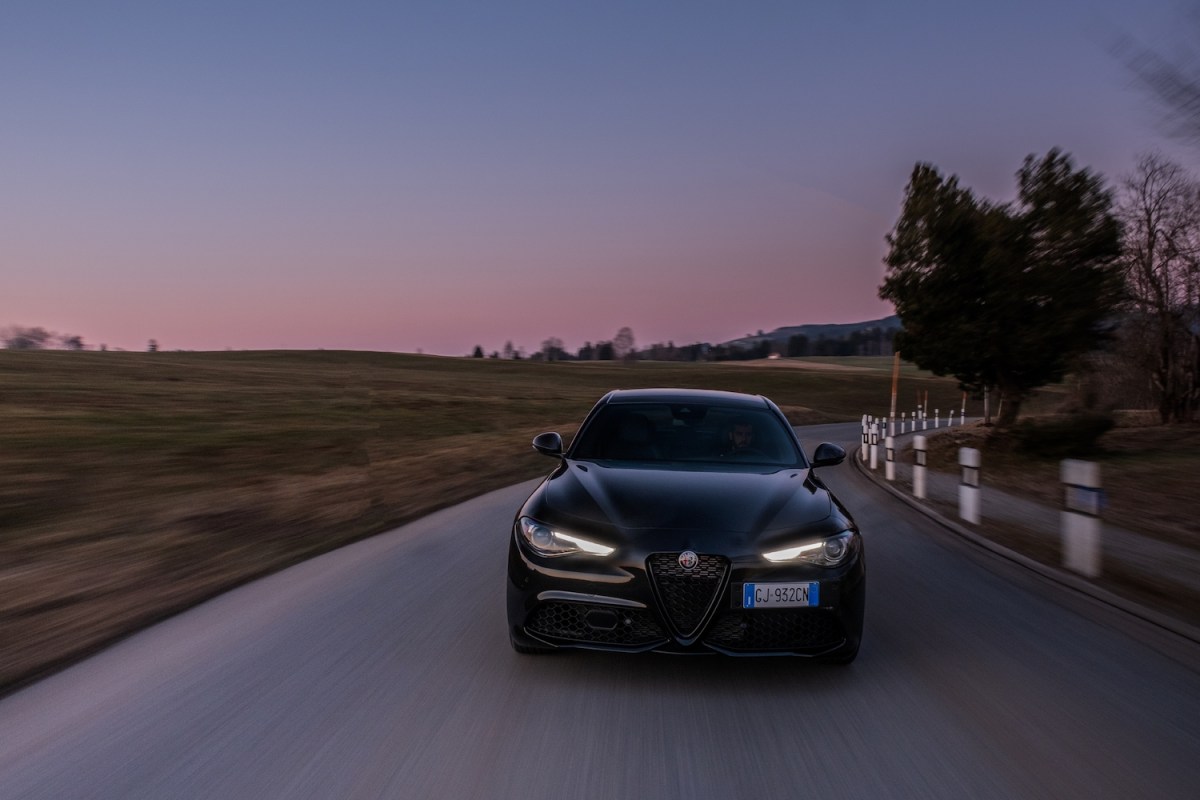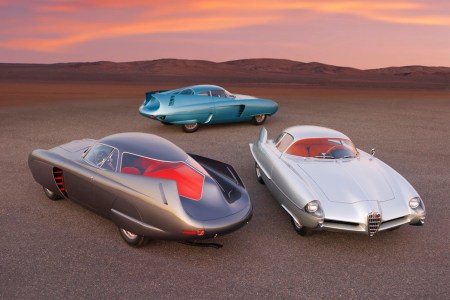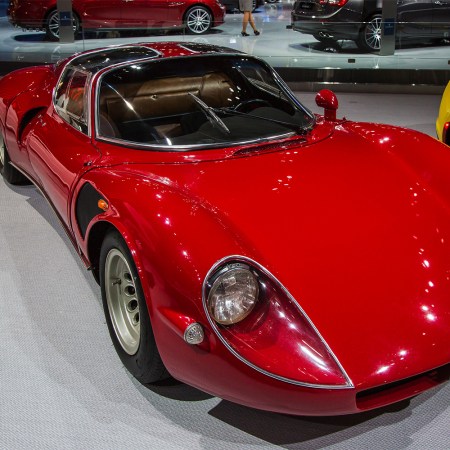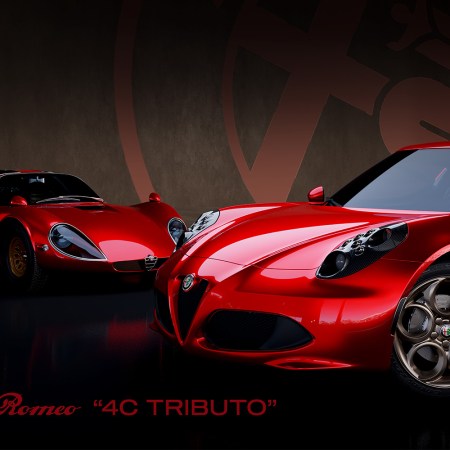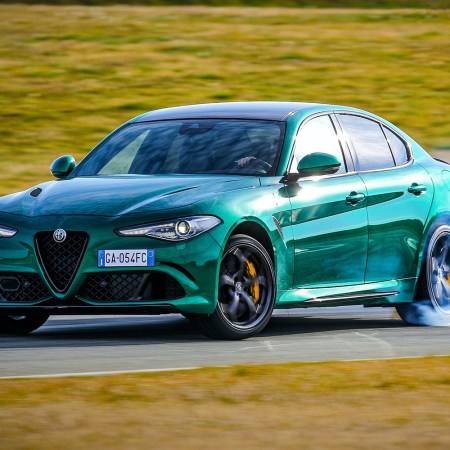To most enthusiasts, the idea of an automobile that borrows nearly everything but the beef from a top-tier performance model is anathema, a pose to be struck by buyers who aren’t willing to pay full freight. In some cases, however, there are compelling reasons to avoid being overcharged for aspects of a vehicle that drivers will simply never use.
This is particularly true when considering an option like the Alfa Romeo Giulia. Already one of the most beautifully-styled shapes on the entry-level luxury scene, it’s most poignant visual package is found when ordered in Quadrifoglio form, an $80,000 track missile that terrorizes the streets (and unwitting owners) with its more than 500 horsepower and EKG-like reflexes.
The Quadrifoglio is inarguably overkill as a daily driver, and when not regularly exercised on a closed circuit it can be hard to justify the compromises (and co-sign on the car payments) that come with it. With this in mind, the new Estrema trim harnesses much of its clover-wearing sibling’s fancy dress and high-tech accoutrements while also tapping in a few of its more manageable handling upgrades — all at a sizable discount when compared to its hair-on-fire fraternal twin.
There’s just one thing that threatens the Alfa Romeo Estrema’s status as the most appealing member of the sedan’s cohort: having to deal with the constant quirks that come as part and parcel of any Alfa Romeo ownership experience.
Forged in Beauty
With flowing lines that evoke the latent musculature of a racehorse at rest, the Alfa Romeo Giulia is a pleasing counterbalance to the extroverted grille shapes and blocky styling that has infiltrated many of the Italian auto’s German rivals. Capturing the essence of movement in the stillness of sheet metal is an art increasingly abandoned by luxury sedans mimicking the bulk of their strong-selling SUV kin, and the Giulia’s turn away from this trend refreshes the eye and renews the soul.
The Estrema trim (which is available exclusively in blue, white, red, and black paint hues) puts in work further refining the Giulia’s visual impact by way of its carbon fiber-style mirror caps and grille surround, its Quadrifoglio-inspired rims, and blacked-out trim and badging. Inside the vehicle, similar carbon accents abound, and a leather dashboard elevates its overall presentation above standard Giulia fare. For those willing to splurge, it’s possible to install a set of wider wheels at the rear (for a staggered setup), as well as sports seats up front.
Not every update made to the Estrema runs along cosmetic lines. The sedan gains an adaptive suspension tune (over and above the three selectable driving modes available to the pilot), as well as a standard limited-slip differential out back. All-wheel drive is optional, as is a host of active safety equipment, but a louder stereo system is par for the course with this trim level.
Why a “Once-in-a-Generation” Trio of Alfa Romeos Is Being Sold at an Art Auction
The B.A.T. 5, 7 and 9 concepts are less of a car collection than a triptychPerpetually Working Out the Bugs
How all of the above comes together out on the road will depend entirely on your personal patience level for an automaker that can’t quite seem to keep in step with industry quality standards. While Alfa Romeo’s willingness to go its own way in terms of styling is to be applauded, its inability to reassure owners that they’ll be able to enjoy the Giulia’s various features in a predictable or even pleasant manner is less of a laurel.
It starts, as with so many issues in modern cars, with the infotainment system. Left to its own devices, the Alfa’s infotainment is inoffensive enough, albeit with a smaller-than-expected screen compared to most other luxury vehicles in its class. That being said, connecting a cabled phone via Android Auto quickly breaks through its façade of competence, with perhaps 6 out of every 10 tries resulting in success (and some of those only making nice with the ones-and-zeros five minutes or so into the drive). Further woe awaits anyone attempting to store their device in the wireless charging pocket on the center console if they don’t have a phone boasting that feature, as the Giulia will spend the remainder of your trip warning you about the “foreign object” it has detected in its cubby.
Also weird: the automated engine start/stop system and its influence on climate control. In the extremely hot weather during my week with the vehicle, the air conditioning compressor was content to continue after the idle was cut off at a stop light, but once I got back on the gas it mysteriously shut down for five seconds or so before roaring back at full blast. It’s distinctly odd to experience AC that runs with the car off, but not once it’s back on, and it added additional sweat to already spicy atmospheric conditions.
The above annoyances are exactly that — irritations that don’t stop the show, but cumulatively wear you down over the course of ownership. And that’s only counting the problems I encountered during a week with the vehicle. Given Alfa Romeo’s bottom-tier standing in terms of reliability in recent years, more serious issues could crop up as well.
Well-Balanced Drive
Grit your teeth and bear the above and you’re treated with a very pleasant drive. The Giulia is intended to ignite passion for squiggly pavement, and its improved suspension setup provides the perfect template for exorcising its nickel-and-dime frustrations by seeking out a session on a secondary road.
Motivated by a 2.0-liter, turbocharged four-cylinder engine that’s good for 280 horsepower and 306 lb-ft of torque, my all-wheel drive model felt lively when set to “Dynamic” drive mode, and comfortably sedate when I was done having fun. The Estrema’s eight-speed automatic transmission was occasionally a little slow to respond to throttle input, but that’s what the enormous shift paddles mounted behind the steering wheel are for, digging in like floppy metal spurs to grind out a gear change.
The Bottom Line
With a starting price of $55,000, this version of the Alfa saves buyers a hefty $25k over the Quadrifoglio while still providing them with a drop-dead gorgeous four-door that can hold its own when blowing off steam on a challenging road. That the Estrema is also far less frenetic than its Quadrifoglio is another feather in its cap. Although priced at $10,000 or so more than the base Giulia, the Estrema is a mere $3,500 more than the next-trim-down Veloce, making it an easy up-sell at ordering time.
Still, when considered as a pure performance play, the Alfa Romeo Giulia Estrema falls further behind by sprinting a full second slower in straight line versus comparably-stickered vehicles sitting in other showrooms. The Estrema might not be able to keep up with overmuscled interlopers like the BMW M340i xDrive, nor match the tech quotient that’s crept to a high level among compact luxury sedans, but it’s still quite interesting from behind the wheel, and considerably more esthetic in its presentation compared to the field at large.
Some might be willing to foot the bill for beauty and drive home content in the knowledge that the Giulia Estrema will have them consistently turning their head to snatch a second look while walking away from a parking space. Others might pound a hole through the steering wheel after their 27th failed attempt to pair their phone to the stereo. Either way, it’s safe to say that the Giulia successfully avoids the luxury mainstream in terms of expectations, for better and for worse.
This article was featured in the InsideHook newsletter. Sign up now.
